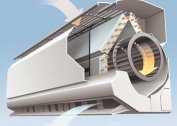The design of the air conditioner contains many different pipes and hoses that move refrigerant and condensate.
Aluminum tubes for air conditioning
Although aluminum tubes for air conditioning are more commonly used in automobiles, this material is gradually gaining ground in domestic and industrial air conditioning.
The advantages of aluminum tubes for air conditioning:
- cheaper, because the reserves in nature are huge;
- easier to expand;
- the wall thickness is thicker, so the design is more durable;
- bends better and does not break;
- for rolling and bending the same equipment is used as for copper;
- easily and quickly (4 times faster) is soldered;
- the length of the pipe in the bays is up to 100 meters, so the number of joints and waste can be reduced;
- withstands up to 18 MPa;
- much slower than copper corrodes and oxidizes;
- conducts heat worse; therefore, it condenses less moisture.
Today they are widely used in fan-coil air conditioning systems, refrigeration units and car air conditioners.
Capillary tubes for air conditioner
A capillary tube for an air conditioner is a copper or brass conduit that plays the role of an expansion tank. The operation of the simplest device is not regulated, so it works for a long time and without failures. The production of capillary tubes for air conditioners is inexpensive. They are widely used in domestic climate systems of low power.
The most effective are calibrated tubes, which pass up to 8 liters of fluid per minute.
According to the requirements, the amount of refrigerant passing through the capillary tube per unit time should be equal to the compressor capacity by weight for the same time.
Between the suction and discharge lines, the tube balances the pressure when the compressor stops.
Minus capillary tubes for air conditioners:
- In the presence of dirt, water or freon, the efficiency is significantly reduced, that is, the performance of the system decreases.
Air conditioner drain pipe
The air conditioning drain pipe is part of the condensate drain system. The hose is attached to the hole located on the bottom of the unit. Condensate tubes of air conditioningand take to the street or directly to the sewer. In the second option, you should consider installing a siphon that does not allow unpleasant odors to enter the room.
The drainage tube of the air conditioner is most often taken out through one channel with a freon track, positioning it obliquely towards the street. It is advisable to purchase a frost-resistant and strong hose for drainage. Such tubes with condensate from the air conditioner will last longer.



